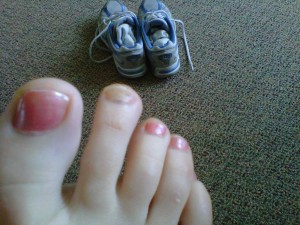When it comes to safety, some things are within your control
I try not to rant too much on this blog, particularly about traffic – we could probably start a whole forum about the scary things we’ve seen on the roads. But I have to tell you, I saw something the other day that was so stupid, I can’t not share it. In this story, the runners are the villains – exactly the kind of thing that makes the rest of us look bad.
I was running down a gravel road where the speed limit is 80 kph. A bit of background for those of you who don’t encounter gravel roads that often: in the spring there is often a LOT of extra gravel laid down to reduce the muck created by the spring thaw. At best, it can be very uncomfortable running since the big rocks poke into your feet and you get very little traction to push off; at worst it can be downright treacherous. Of course, paths are created through the gravel by the vehicle tires tossing the gravel aside, and sometimes there are only 3 tracks, instead of the expected 4, due to traffic staying towards the more solid centre of the road.
Off in the distance I could see 2 figures side-by-side in the northbound tracks but was too far back to tell what they were. Then I saw a pick-up truck coming north (I was headed south on the northbound side of the road, facing traffic, of course) that crossed over to the southbound lane to pass the figures. I thought to myself, how inconsiderate of them to hog half the road.
When I got closer, I realized they were runners, and not only were they running in the middle of the road, they were running north in the northbound lanes. They probably didn’t even know the truck was THERE until it was too late to move over, so it’s a good thing they were in a spot with a clear line of sight, and the driver was paying attention.
But wait, it gets better. One of the runners was a young girl, maybe 12 or 13, and the other was a woman (a coach? parent? family friend?). What? You are running with this girl, being a role model of some kind, and this is what you’re modelling? Seriously, folks, there are enough hazards on the roads if you ARE following all the rules, why would you go out of your way to make it worse?




 “Never does the human soul appear so strong as when it foregoes revenge and dares to forgive an injury.”
“Never does the human soul appear so strong as when it foregoes revenge and dares to forgive an injury.” Current Issue
Current Issue Previous Issue
Previous Issue Prior Release
Prior Release
